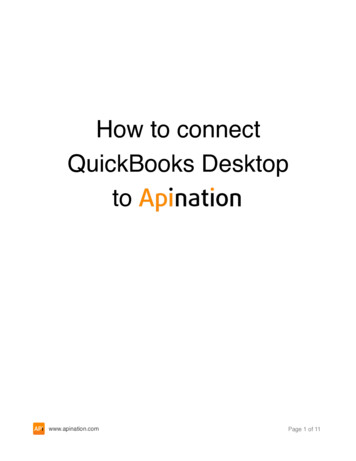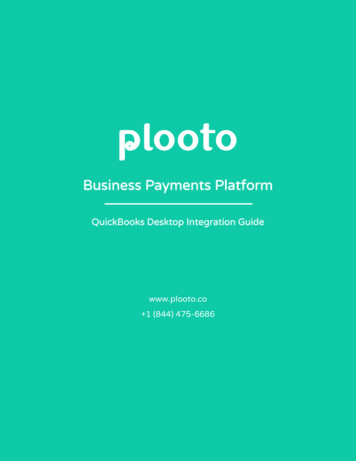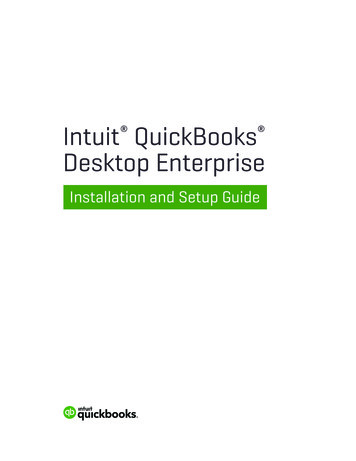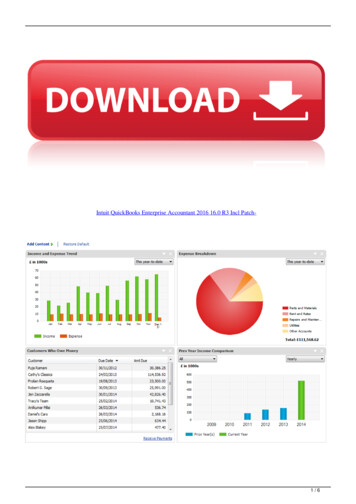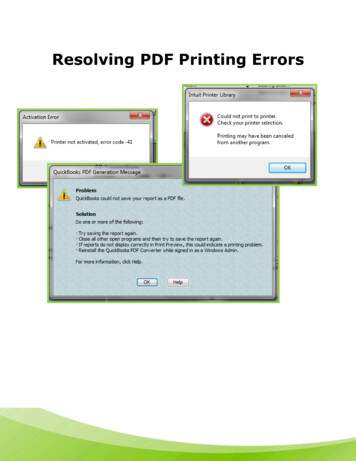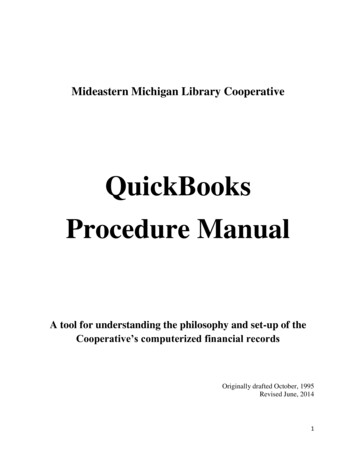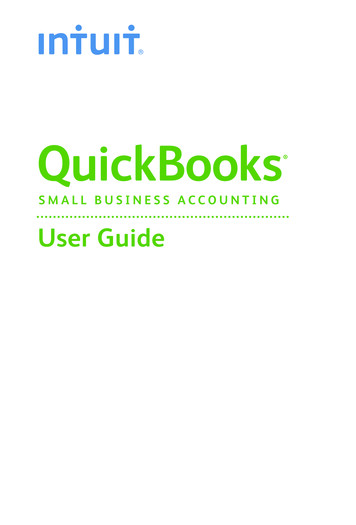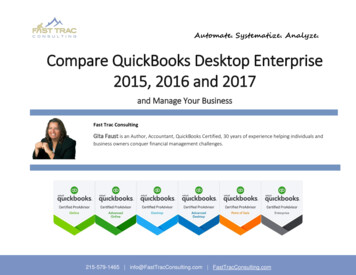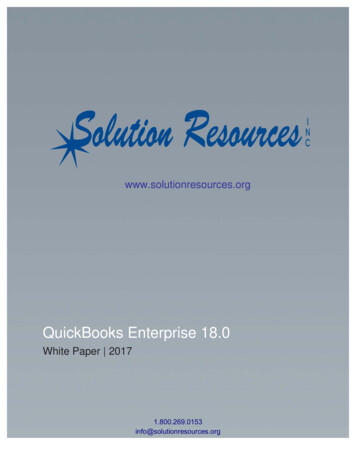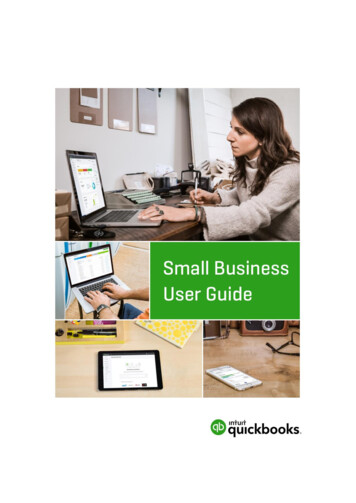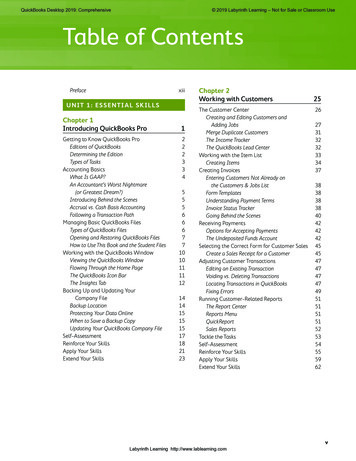
Transcription
QuickBooks Desktop 2019: Comprehensive 2019 Labyrinth Learning – Not for Sale or Classroom UseTable of ContentsPrefacexiiiU NIT 1: ESSENTIAL SKIL LSChapter 1Introducing QuickBooks ProGetting to Know QuickBooks ProEditions of QuickBooksDetermining the EditionTypes of TasksAccounting BasicsWhat Is GAAP?An Accountant’s Worst Nightmare(or Greatest Dream?)Introducing Behind the ScenesAccrual vs. Cash Basis AccountingFollowing a Transaction PathManaging Basic QuickBooks FilesTypes of QuickBooks FilesOpening and Restoring QuickBooks FilesHow to Use This Book and the Student FilesWorking with the QuickBooks WindowViewing the QuickBooks WindowFlowing Through the Home PageThe QuickBooks Icon BarThe Insights TabBacking Up and Updating YourCompany FileBackup LocationProtecting Your Data OnlineWhen to Save a Backup CopyUpdating Your QuickBooks Company FileSelf-AssessmentReinforce Your SkillsApply Your SkillsExtend Your hapter 2Working with CustomersThe Customer CenterCreating and Editing Customers andAdding JobsMerge Duplicate CustomersThe Income TrackerThe QuickBooks Lead CenterWorking with the Item ListCreating ItemsCreating InvoicesEntering Customers Not Already onthe Customers & Jobs ListForm TemplatesUnderstanding Payment TermsInvoice Status TrackerGoing Behind the ScenesReceiving PaymentsOptions for Accepting PaymentsThe Undeposited Funds AccountSelecting the Correct Form for Customer SalesCreate a Sales Receipt for a CustomerAdjusting Customer TransactionsEditing an Existing TransactionVoiding vs. Deleting TransactionsLocating Transactions in QuickBooksFixing ErrorsRunning Customer-Related ReportsThe Report CenterReports MenuQuickReportSales ReportsTackle the TasksSelf-AssessmentReinforce Your SkillsApply Your SkillsExtend Your 474951515151525354555962vLabyrinth Learning http://www.lablearning.com
QuickBooks Desktop 2019: Comprehensive 2019 Labyrinth Learning – Not for Sale or Classroom UseChapter 3Working with Vendors63The Vendor CenterThe Vendor ListMerge Duplicate VendorsEntering BillsThe Importance of Entering ReferenceNumbers and MemosPassing on Expenses to CustomersPaying BillsPayment DetailsThe Payment Summary WindowWriting and Printing ChecksCheck to Pay BillsPrint Checks SetupPrinting ChecksEditing Vendor TransactionsFixing ErrorsProducing Vendor and Profit & Loss ReportsQuickZoomThe Profit & Loss (P&L) ReportWorking with QuickBooks GraphsTackle the TasksSelf-AssessmentReinforce Your SkillsApply Your SkillsExtend Your 889295Chapter 4Performing Banking TasksMoving Funds Between AccountsWorking with an Account RegisterThe Chart of AccountsSearching in the Chart of AccountsCreating and Editing AccountsMaking DepositsManaging Credit and Debit Card TransactionsType of Account and Normal BalanceDealing with Debit Card TransactionsOther Types of Transactions Affectingthe Checking AccountPaying a Bill with a Credit CardDealing with Bounced ChecksReconciling AccountsWhen Your Accounts Don’t MatchReconciling Credit CardsFixing Banking TransactionsFixing ErrorsWorking with Banking and BalanceSheet ReportsBanking ReportsQuickReports from the RegisterReconciliation ReportsAlternatives to Printing ReportsBalance Sheet ReportsCompany SnapshotImporting Banking Transactions intoQuickBooksThe Modes of Bank FeedsBank Feeds and ReconciliationSetting Up Bank Feeds in QuickBooksMatching and Recording Bank FeedsAttaching a File to a TransactionTackle the TasksSelf-AssessmentReinforce Your SkillsApply Your SkillsExtend Your SkillsTable of ContentsLabyrinth Learning 6127127127127129130132133138142
QuickBooks Desktop 2019: Comprehensive 2019 Labyrinth Learning – Not for Sale or Classroom UseChapter 5Creating a Company FilePlanning and Creating a CompanyChoosing Your Start DateCreating a New QuickBooks FileChoosing a Setup PathA Setup ChecklistA Quick Payroll PrimerYour Starter Chart of AccountsAccount Beginning BalancesEditing Your QuickBooks PreferencesCompany vs. Personal PreferencesCustomizing a Company FileModifying the Lists in a New FileThe Chart of AccountsCustomizing the Chart of AccountsSubaccountsUsing Classes in QuickBooksWorking with Opening Balances andHistorical TransactionsEntering and Editing AccountOpening BalancesEntering Historical Transactions foran AccountFinding Help in QuickBooksThe “Have a Question?” WindowSetting Up UsersAdministrators and UsersSetting PasswordsWorking with QuickBooks in aMulti-User EnvironmentClosing the Books and Running List ReportsKeeping the End in MindThe Report CenterList Reports in QuickBooksEmail Functionality in ReportsTackle the TasksSelf-AssessmentReinforce Your SkillsApply Your SkillsExtend Your SkillsUN I T 2: ADVA N CE D S K I 70171174Chapter 6Managing Physical InventoryTracking Inventory in QuickBooksShould I Use QuickBooks to TrackMy Company’s Inventory?Tracking Inventory SalesSetting Up the Item ListTwo-Sided ItemsAdd/Edit Multiple List EntriesDealing with Sales Tax in QuickBooksSales Tax Items and GroupsDefault Tax RateDealing with Multiple Sales Tax RatesSales Tax CodesCreating Purchase OrdersNon-Posting AccountsReceiving ItemsTwo Methods of Receiving ItemsIncluding Expenses on a Bill for ItemsDiscount Payment TermsSelling Inventory ItemsSelling Inventory for Cash and On AccountSend a Batch of FormsReceiving Discounted and ElectronicPaymentsWorking with Electronic CustomerPayments/Wire TransfersThe Shipping ManagerWorking with RefundsCreating a Credit MemoEntering a Credit from a VendorProducing Inventory ReportsTracking SalesTackle the TasksSelf-AssessmentReinforce Your SkillsApply Your SkillsExtend Your 14218222177Table of ContentsLabyrinth Learning http://www.lablearning.comvii
QuickBooks Desktop 2019: ComprehensiveChapter 7Working with Balance SheetAccounts and BudgetsWorking with Other Current AssetsBalance Sheet AccountsPaying Down the Other CurrentAsset AccountMemorizing TransactionsTracking Petty CashEnd of Month Entry OptionRecording MethodsWriting Off Uncollectable ReceivablesTreating Bad Debt as a DiscountUsing a Credit Memo to Write Off aBad DebtTreating Bad Debt as an AllowanceWorking with Fixed AssetsSetting Up Fixed Assets in QuickBooksDepreciationAccumulated DepreciationFixed Asset ItemsAccountant Tool: Fixed Asset ManagerDealing with Current LiabilitiesSales Tax PayableSetting Up a Long Term LiabilityThe QuickBooks Loan ManagerWorking with Equity AccountsOwner’s Equity / Capital StockRetained EarningsOpening Balance EquityBudgeting and Predicting in QuickBooksBudget ReportsPredicting the Future Cash FlowTackle the TasksSelf-AssessmentReinforce Your SkillsApply Your SkillsExtend Your Skillsviii 2019 Labyrinth Learning – Not for Sale or Classroom UseChapter 8Using QuickBooks for 258262265Working with Employees in QuickBooksManaging the Employees ListSetting Employee DefaultsWorking with an Outside Payroll ServiceInformation to TrackEnter Information from the OutsideService into QuickBooksSetting Up QuickBooks to Run PayrollPayroll Recordkeeping in QuickBooksEvaluating Payroll OptionsCommon Mistakes When UsingQuickBooks for PayrollEntering Historical AmountsPayroll DeductionsThe Payroll Setup InterviewPayroll ItemsWorkers’ Compensation InsuranceCreating PaychecksWorking with Payroll SchedulesPassing On Billable Time to CustomersAssigning Sick or Vacation HoursTracking and Paying Payroll LiabilitiesThe Pay Payroll Liabilities WindowCorrecting Payroll ErrorsFixing a PaycheckMaking Corrections to a PayrollLiability PaymentWorking with 1099s and Processing PayrollForms and ReportsW-2s and W-3s940 and 9411099-MISC and 1096Other Payroll ReportsTackle the TasksSelf-AssessmentReinforce Your SkillsApply Your SkillsExtend Your SkillsTable of ContentsLabyrinth Learning 4296296296296297299300301304308
QuickBooks Desktop 2019: Comprehensive 2019 Labyrinth Learning – Not for Sale or Classroom UseChapter 9Job Costing, Creating Estimates, and TimeTracking309Chapter 10Customizing and Integratingin QuickBooksJob CostingJob ProfitabilityCreating an Estimate for a JobCreate a Progress InvoiceUnearned IncomeCustomer DepositsPassing on Expenses to CustomersAssessing Finance Charges and ProducingStatementsThe Assess Finance Charges WindowRemove a Finance ChargeCreating Statements for CustomersTime Tracking and Mileage FeaturesMethods of Entering TimeBatch TimesheetsTracking MileageUsing Time Tracking Hours for Paychecksand InvoicesJobs, Time & Mileage Tracking ReportsTime Tracking with TSheetsPrecision & Reduced Payroll ProcessingTimeQuickBooks IntegrationScheduling and GPSTackle the TasksSelf-AssessmentReinforce Your SkillsApply Your SkillsExtend Your SkillsWorking with Customer & VendorProfile ListsDesignating Sales Reps in QuickBooksMaking the Lists Work for YouCreating Custom FieldsAdding Custom FieldsSetting Price LevelsSetting Billing Rate LevelsCustomizing Reports and GraphsDisplay PropertiesFiltering ReportsFormatting Fonts and NumbersAdditional Report Formatting OptionsHeader and Footer OptionsPage LayoutMemorizing ReportsSpecialized ReportsCreating Custom FormsTemplatesCreating a Custom TemplateUsing Custom Fields in Forms and ReportsThe Layout Designer WindowIntegrating with Microsoft OfficeSending Letters with WordExporting QuickBooks Reports to ExcelUsing Excel to Import Multiple ListEntries into QuickBooksTackle the TasksSelf-AssessmentReinforce Your SkillsApply Your SkillsExtend Your 374374374378380381382386388Table of ContentsLabyrinth Learning http://www.lablearning.comix
QuickBooks Desktop 2019: Comprehensive 2019 Labyrinth Learning – Not for Sale or Classroom UseChapter 12Reporting, Adjusting Entries,and Closing the BooksU N IT 3: ADDITIONAL SKIL L SChapter 11Introducing the Accounting Cycleand Using Classes389The Accounting Cycle and GAAP390Time to Review Generally Accepted AccountingPrinciples (GAAP)390The Accounting Cycle and Fiscal Period391Collecting and Verifying Source Documents392The QuickBooks Doc Center392Cycle Step 1: Analyze Business Transactions394Working with Classes395A Class Example396Planning for Class Tracking396Using Classes for Profit Center Reporting396Utilizing Subclasses397Applying Classes to Transactions398Consistent Class Applications398Cycle Step 2: Record Journal Entries398Cycle Step 3: Post Journal Entries399Running Class Reports401The Profit & Loss Unclassified Report401The Profit & Loss by Class Report401The Balance Sheet by Class Report403Adding a Class Field to Reports403Running the Journal Report403Producing a Statement of Cash Flows405Method of Reporting405Forecasting Cash Flow407The Accounting Cycle in Practice408Tackle the Tasks409Self-Assessment410Reinforce Your Skills411Apply Your Skills414Extend Your Skills417xClosing the Books in QuickBooksThe Final Steps of the Accounting CycleQuickBooks’ Automatic Year-EndAdjustmentsPreparing for Year-End ReportingQuickBooks Reporting CapabilitiesCycle Step 4: Unadjusted Trial BalancePreparing a WorksheetDigging in Behind the Scenes withAdjusting EntriesThe Accounting Cardinal Rule: Debitsand Credits Must Always Be EqualMaking Journal EntriesCycle Step 5: Adjusting Entries andAdjusted Trial BalanceAdjusting Inventory Quantity/Valueon HandAccounting for DepreciationPreparing Financial StatementsCycle Step 6: Financial StatementsThe Income StatementThe Balance SheetThe Statement of Owner’s EquityCreating Reports to Compare Datafrom Previous Fiscal PeriodsWrapping Up the Accounting Cycle andClosing the BooksCycle Step 7: Closing Entries andPost-Closing Trial BalanceSetting a Closing DateWorking with a Company File After ClosingCorrecting Transactions from a ClosedPeriodThe Audit TrailCondensing the Company FileWorking with an Accountant’s CopyTackle the TasksSelf-AssessmentReinforce Your SkillsApply Your SkillsExtend Your SkillsTable of ContentsLabyrinth Learning 0440440441444445447450452
QuickBooks Desktop 2019: Comprehensive 2019 Labyrinth Learning – Not for Sale or Classroom UseChapter 13Bringing It All Together!Session #1: The Company File and ListsSession #1 DataSession #1: DeliverablesSession #2: Day-to-Day WorkSession #2: DataSession #2: DeliverablesSession #3: Wrap It UpSession #3: DataSession #3: DeliverablesSession #1: The Company File and ListsSession #1: DataSession #1: DeliverablesSession #2: Day-to-Day WorkSession #2: DataSession #2: DeliverablesSession #3: Wrap It UpSession #3: DataSession #3: 4475475486486486487Appendix ANeed to Know Accounting489Working with Financial StatementsThe Accounting Equation and theBalance SheetThe Income Statement(aka Profit & Loss Report)Debits and Credits:The Double-Entry Accounting SystemTypes of Accounts and Normal BalancesThe Trial Balance Report490492493494Self-Assessment Answer KeyGlossaryIndex495499503490492Table of ContentsLabyrinth Learning http://www.lablearning.comxi
Fixed Asset Items 240. Accountant Tool: Fixed Asset Manager 241. Dealing with Current Liabilities 243 Sales Tax Payable 243 Setting Up a Long Term Liability 246 The QuickBooks Loan Manager 246. Working with Equity Accounts 251 Owner’s Equity / Capital S
